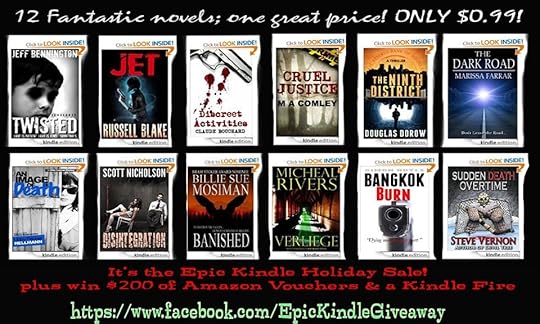Libby Fischer Hellmann's Blog, page 53
January 23, 2013
Beauty’s Only Skin Deep… really?
So, here’s an interesting experiment. At least I hope you’ll think so.
About two years ago, I changed the covers on my four Ellie Foreman mysteries. They weren’t connected as a series, and since they’d been given a new life as ebooks, I thought they should be. I loved what the graphic designer from PR Chicago came up with (and I recommend them highly)…
[image error] [image error] [image error] [image error]
I did the requisite promotions, tried to bring them to readers’ attention, then waited to see what would happen. All the books sold better— except one. Can you figure out which one? I suspected it, but waited to see if, perhaps, I was wrong. I did a couple of free days with each, and the results were clear. One wasn’t performing as well as the others.
Knowing how important it is to have a cover that pops, I finally asked the designer to revise the cover. Here’s the new version:
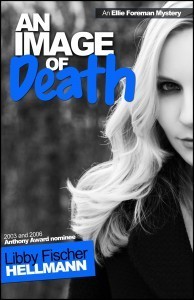
I’ll be showing it around over the next month or so, and I’m very curious to see if it sells better than the other version. I’ll keep you posted on the results. In the meantime, what do you think?
January 22, 2013
There She Goes Again…
It’s time for a rant. I try not to impose on your forbearance, but I need to talk. Don’t get me wrong, I’m not angry, or about to blow up… I just want to go on (and on) about something. So if the subject matter doesn’t interest you, just scroll down to the bottom where I bring up something completely different. If you do decide to read this, get comfortable.
Some of you know I was a history major, and I still love to make connections between the past and the present: how we learn or don’t; how we repeat mistakes but with a slightly different twist because we think we’ve learned; how we end up pretty much in the same place.
As you probably know, 2013 marks the 50th anniversary of JFK’s Assassination, and everyone is already trotting out all the old conspiracy theories, certain that they have the answer to his murder. Did you know there are over 500 books related to the JFK Assassination? They can’t ALL be right, can they?

The Riderless Horse
Well, before I go there, a personal digression, which might explain why I still think and care about this 50 years later. I grew up in Washington, DC, and when Kennedy came into office, it was like a lightning bolt struck the town. No longer was DC the sleepy southern unbearable-in-summer city; now it was going to be young, full of VIGAH (remember that?), artists, musicians, and sophisticated French food and fashion. To celebrate, my mother took me down to the inauguration in 1961. We staked out on Constitution Avenue, watched the parade and saw Jackie and Jack drive past in their limo. I remember feeling excited and hopeful about the future and this glamorous Presidential couple.
Less than three years later my mother and I were back in the same spot , this time watching the funeral cortege. I was older, sadder, and I’ll never forget the riderless horse with the stirrups on backwards. I felt cheated. Robbed. Personally.
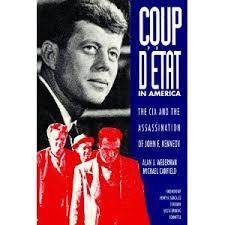
Maybe that’s why I became so interested in the conspiracy theories. I read a lot of the books, but the ones that made sense all implicated three major perpetrators: Castro, the CIA, or the Mafia.
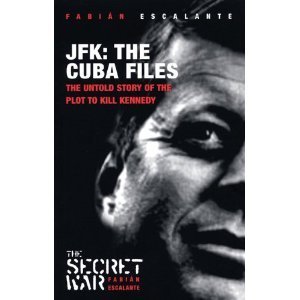 This one, which I read early on, said the CIA was the culprit and based their theory on photos of Howard Hunt and Frank Sturgis dressed as “hobos” and/or “tramps” who were questioned by Dallas police and then released. (Amazing how many mistakes the Dallas police made back then… but that’s a conspiracy for another day)
This one, which I read early on, said the CIA was the culprit and based their theory on photos of Howard Hunt and Frank Sturgis dressed as “hobos” and/or “tramps” who were questioned by Dallas police and then released. (Amazing how many mistakes the Dallas police made back then… but that’s a conspiracy for another day)
JFK: THE CUBA FILES was written by a Cuban and I read it while I was in Cuba last winter. I found it to be well researched, and it convinced me that Castro had nothing to do with it.
Which leaves the Mafia… and that’s what Lamar Waldron and Thom Hartman’s ULTIMATE SACRIFICE and LEGACY OF SECRECY address. These are not new books, btw, and both are MUCH too long and repetitive. But they are convincing, not so much because they single out the Mafia as the culprits, but because they combine all three groups.
Essentially what these books say is this: Carlos Marcello, Santo Trafficante, and Johnny Roselli colluded to kill JFK because brother Bobby had been aggressively targeting them as Attorney General. However, the reason the subsequent Warren Commission whitewash and cover-up succeeded was because the Mafia had infiltrated a super secret Kennedy plan to stage a coup in Cuba. The authors document how the RFK had enlisted Juan Almedia, a high ranking Cuban government official who was disillusioned with Castro, to help carry out the coup; of course, the US would provide assistance afterwards.
The coup was planned for December 1st 1963, but, after the death of JFK on November 22, it was aborted. However, the Mafia was able to extort silence from RFK, Johnson, Hoover, and others by threatening to expose the coup, which, people feared would provoke a serious confrontation with the Soviets, not even a year after the Cuban Missile Crisis. Maybe even World War Three.
Interesting, no?
I won’t go into a lot of detail – you can read the books yourself. But I find their theory compelling for a bunch of reasons:
–Whatever theory you believe, there’s a list of people who are always mentioned as people who knew more than they’ve told about the assassination. Those people are both CIA, Mafia, and Cuban exiles.
– It’s been documented that the CIA and the Mafia worked together many times over the years … as far back as WW2 in Sicily, in Guatemala, Cuba, and other places.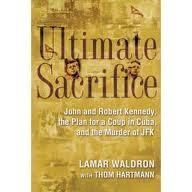
– Several Cuban exiles (on the more liberal side) were to be involved in Kennedy’s coup plan, not to the extent they were during the Bay of Pigs, but still involved.
– Marcello was often quoted as saying any assassination needed a patsy to blame it on, like they did back in Sicily. Enter Lee Harvey Oswald.
– Lee Harvey Oswald was a sometime asset or employee of the CIA. (How did Stephen King, whom I love, get it so wrong?)
– Jack Ruby was a known Mob associate of Marcello and Rosselli.
– There were supposed to be attempts on JFK’s life in Chicago and Tampa during the weeks leading up to Dallas, but they didn’t happen for one reason or another. The same men were involved in all three attempts, including a French assassin close to the heroin trade, sharpshooter Mafia hit men, and possibly a Cuban exile.
It sure puts a different spin on Bobby Kennedy, doesn’t it? How would you like to carry around the guilt of knowing your behavior, in part, caused your brother’s death? And that you couldn’t do anything to avenge it? It’s almost the stuff of a Shakespeare tragedy. Btw, Robert Kennedy Junior, his son, concurs that the Mafia was behind JFK’s death and that RFK knew it. The authors go even further and implicate the Mob for Martin Luther King and ultimately RKF’s murders as well.
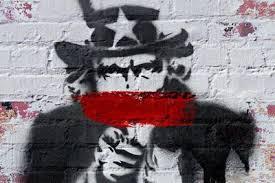 I think they have a pretty sound theory about JFK. Except for one thing— and here’s where Oliver Stone comes in. No, not his film JFK, but his recent Untold History of the United States, (on Showtime) which I highly recommend for anyone who wants a fascinating perspective on our history during the past 75 years. He paints Khrushchev as a peace-maker and a leader who took internal risks that we only are just discovering to keep the US and the USSR on an even keel. He knew the US would pulverize Russia if it came to war. So he tried his best to avoid it. His efforts were trumped only by Gorbachev thirty years later.
I think they have a pretty sound theory about JFK. Except for one thing— and here’s where Oliver Stone comes in. No, not his film JFK, but his recent Untold History of the United States, (on Showtime) which I highly recommend for anyone who wants a fascinating perspective on our history during the past 75 years. He paints Khrushchev as a peace-maker and a leader who took internal risks that we only are just discovering to keep the US and the USSR on an even keel. He knew the US would pulverize Russia if it came to war. So he tried his best to avoid it. His efforts were trumped only by Gorbachev thirty years later.
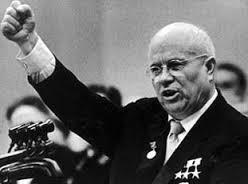
Stone delivers a persuasive argument, and I just wonder if anyone back then knew it. If so, perhaps the fear that we would end up in a nuclear war was exaggerated. We sure had an effective propaganda machine telling us that was the case. Then again, maybe the CIA and our foreign affairs leaders really didn’t know much about Khrushchev. Maybe they really did consider him our biggest threat. I wish there was a way to find out.
Maybe we will in 2017. That’s when the rest of the files on the JFK assassination are supposed to be released.
New Subject (for those who skipped the above)
Anyway, it just so happens my next book takes place largely in Cuba before the revolution and then twenty years afterwards. It’s called HAVANA LOST, and it will be out this spring. As a hybrid author (I just learned that’s what we’re called when we are both traditionally and self-published), I will be bringing it out myself. I want to do it “right,” and I thought some of you might be interested in my progress. As time allows, I plan to keep you informed. And also share some of my thoughts about writing, Cuba, Fidel, and the Mafia.
In the meantime, those of you who are even a little bit fascinated by Cuba should check out a series of blogs by author Jack Durish. He’s done an amazing job tracing the island’s history. You can find them right here.
And if you’ve made it this far, I owe you a beer. Or beverage of your choice. Thanks.
January 15, 2013
Set the Night on Fire
A winter book for the winter season, SET THE NIGHT ON FIRE is a stand-alone thriller that goes back, in part, to the late Sixties in Chicago. Best of all, it’s just 99 cents all week at Kindle and Nook.
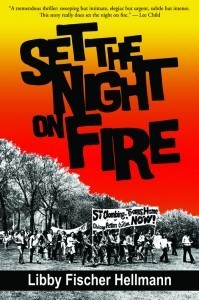 Someone is trying to kill Lila Hilliard. During the Christmas holidays she returns from running errands to find her family home in flames, her father and brother trapped inside. Later, she is attacked by a mysterious man on a motorcycle. . . and the threats don’t end there. As Lila desperately tries to piece together who is after her and why, she uncovers information about her father’s past in Chicago during the volatile days of the late 1960s . . . information he never shared with her, but now threatens to destroy her. Part thriller, part historical novel, and part love story, Set the Night on Fire paints an unforgettable portrait of Chicago during a turbulent time: the riots at the Democratic Convention . . . the struggle for power between the Black Panthers and SDS . . . and a group of young idealists who tried to change the world.
Someone is trying to kill Lila Hilliard. During the Christmas holidays she returns from running errands to find her family home in flames, her father and brother trapped inside. Later, she is attacked by a mysterious man on a motorcycle. . . and the threats don’t end there. As Lila desperately tries to piece together who is after her and why, she uncovers information about her father’s past in Chicago during the volatile days of the late 1960s . . . information he never shared with her, but now threatens to destroy her. Part thriller, part historical novel, and part love story, Set the Night on Fire paints an unforgettable portrait of Chicago during a turbulent time: the riots at the Democratic Convention . . . the struggle for power between the Black Panthers and SDS . . . and a group of young idealists who tried to change the world.
“A tremendous book – sweeping but intimate, elegiac but urgent, subtle but intense. This story really does set the night on fire.” –Lee Child
“A brilliantly-paced thriller, transitioning seamlessly from modern-day Chicago to the late ’60s. First-rate characterization…Best to start early in the day, as it is easy to stay up all night reading it.” –Foreword Magazine
“RT Top Pick for December: “Electric… a marvelous novel.”
–RT Book Reviews
“Set the Night on Fire is a compelling story of love, truth and redemption. This will be a break-out novel for this talented writer. Highly recommended.” –Sheldon Siegel, NYTImes bestselling author of Perfect Alibi
“A top-rate thriller that taps into the antiwar protests of the 1960s… A jazzy fusion of past and present, Hellman’s insightful, politically charged whodunit explores a fascinating period in American history.”
–Publishers Weekly
Again, you can find it here. And here.
January 13, 2013
Yo, Chicago: Your History is Calling…

I’m both embarrassed and proud.
Embarrassed because I’ve lived in Chicago almost 35 years but never really knew much about Jane Addams and Hull House until yesterday.
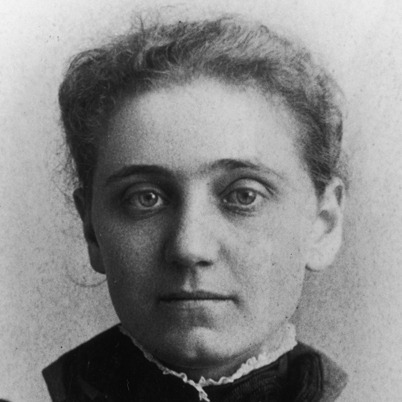
Proud because such an amazing woman and the institutions she created are part of my “home town” history.
I had the opportunity to tour Hull House Museum yesterday and was overwhelmed by what one person can accomplish in a lifetime. First, the woman. Jane Addams, born in 1860, was the daughter of a well-off father. She grew up in Cedarville, a small Illinois town where her father was a mover and shaker. He also instilled in her a love of reading. She subsequently developed a social conscience, reading lots of Dickens (who says literature can’t affect a person’s life?) and decided she wanted to help the less fortunate. As a young woman, she thought becoming a doctor would accomplish her goal, but that didn’t work out. Eventually, after visiting London’s Toynbee House, she decided to join the early settlement pioneers who were committed to improving the life of others within the framework of a democratic society. She moved to Chicago with her college friend Ellen Gates Starr and in 1889 eventually started Hull House.
What was Hull House?
Think community center on steroids. Jane was apparently a very persuasive person. When she saw a need for something, she either motivated herself or others to provide a solution. Over a thirty year period spanning the turn of the century, Hull House expanded to a campus of 13  buildings, all dedicated to improving life for the residents of the 19th Ward of Chicago. Whether it was lobbying for garbage collectors to clean up the streets, establishing a day care center for children of immigrants, creating a theater program, a crafts school, or what we now know of as adult education, it happened at Hull House.
buildings, all dedicated to improving life for the residents of the 19th Ward of Chicago. Whether it was lobbying for garbage collectors to clean up the streets, establishing a day care center for children of immigrants, creating a theater program, a crafts school, or what we now know of as adult education, it happened at Hull House.
She started a “half-way” house of sorts where working women could live, at least temporarily; developed a bathhouse for children who had never had one; even started a coffeehouse and gym.
On a broader scale, whether it was voting rights for women, stricter child labor laws, advocating for better housing, or developing statistical methods of studying a neighborhood that are still used today, there weren’t a lot of issues Addams did not get involved in. Along the way she cultivated a coterie of men and women who were equally devoted to those causes. Some not only contributed money but became residents at Hull House while they worked on turning their dreams into a reality.
Speaking of broader scales, she was very well traveled. I think she might have had a crush on Trotsky, and there’s a letter from Gandhi in her bedroom. Oh, and did I mention she was the first American woman to win a Nobel Prize in 1931?
It’s too bad the words “Socialist” and “Community Organizer” have been used to criticize those who care about improving the lot of others, because that’s what Jane Addams did. And believed in. Even so, she fiercely refused to let people define her as a Socialist or a Progressive or a Pacifist. She didn’t believe in labels. She just thought that those who were more fortunate had a responsibility to help those who weren’t.
Simple stuff. But she made it happen. And didn’t give up until it did
As you might imagine, her opinions and writings did not sit well with some. Here is a photo of her FBI file. It’s quite thick, maybe 3-4 inches.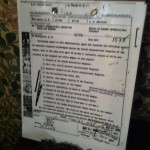
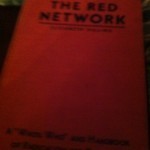
She also merited a several page spread in this book.
If you live near Chicago, it is worth the hour to tour the Museum, especially on a winter day when there’s not much else to do. If you’re not from Chicago, put it on your list of sites to see next time you come to town.
January 4, 2013
Anatomy of Crime Fiction: Building Suspense
[image error]
Last year I started a series of one-day workshops devoted to the craft of crime fiction. They’re broken up into various segments, but I wanted to summarize one of the most popular: Building Suspense . Btw, this isn’t limited to crime fiction as you’ll see. But it is a rather long post, so curl up with your favorite beverage before reading. If you like it, let me know and I may do some of the other segments going forward.
JACK BAUER AND ME: BUILDING SUSPENSE
The president of the United States was held hostage. Jack Bauer was prosecuted for torture. A nuclear bomb exploded over Los Angeles. Remember 24? If you don’t, I recommend watching a season or two on DVD. The plot machinations were over the top, and some of the dialogue was so lame it was dead-to-rights funny. But nowhere else could you see so many edge-of-your-seat stories presented and drawn out, sometimes over the course of an entire season. You might have turned away for a while, but I’ll bet you always came back. I know I did. I was hooked on the adrenaline, the emotional investment, the potential for disaster.
What 24—and its successors, such as MI-5, the Jason Bourne films, and even HOMELAND, do relentlessly well is build suspense. And although you are writing a novel, not a screenplay or teleplay (that’s another article), shows like 24 visually incorporate many of the basic precepts of suspense every thriller writer needs to master. Which is why I may occasionally reference Jack and friends going forward.
Suspense Defined
Whether it is a global or an individual crisis, suspense is not so much what is happening as what may happen. It’s about anticipation, often anticipating the worst. It’s about creating an uncertain situation in which the outcome is in doubt. It’s asking a question not immediately answered, raising a concern not immediately addressed, posing a threat not immediately resolved.
Notice that immediately is the key word. Suspense depends on stretching out time—delaying the answers as long as possible. The longer a writer can stretch and delay, the longer information is parceled out in bits and pieces, the more suspense there is.
Before I was a writer, I was a reader. I read John le Carré, Robert Ludlum, Ken Follett, Len Deighton, Frederick Forsyth, and more. (With the exception of romantic suspense, the genre was dominated by men back then.) I loved the nail-biting scenes, the emotional roller coasters, the utter inability to put a book down. I knew then, way before I wrote my first novel, that suspense would be an integral part of my craft.
But suspense isn’t limited to crime thrillers. Any story with a secret, with tension, or with an unresolved conflict is ripe for the kind of unbearable, exquisite suspense so many of us love. Consider some of the classics: To Kill a Mockingbird, Moby Dick, Wuthering Heights, The Great Gatsby. All of them use suspense to heighten interest and emotion. Contemporary authors too, including Jodi Picoult, Jane Smiley, Jonathan Franzen, Michael Chabon, incorporate suspense in their novels.
In fact, suspense should be an essential part of every author’s tool kit. To that end, following are some techniques of suspense culled from master storytellers, authors you may know, and even Jack Bauer.
The Hook
The first line of a novel gives readers an indication of the voice, character, and sometimes setting. But that first sentence must also provoke, tease, or set up a situation that compels the reader to keep reading. First lines need to have enou
gh inherent suspense to hook the reader at the outset. Consider the following:
“The man with ten minutes to live was laughing.” The Fist of God by Frederick Forsyth
“The small boys came early to the hanging.” Pillars of the Earth by Ken Follett
“For a week, the feeling had been with him, and all week long young Paul LeBeau had been afraid.” Iron Lake by William Kent Krueger
“Ricki Feldman is best admired from a distance—if you get too close, you might find some of your body parts missing.” An Image of Death by Libby Fischer Hellmann
“I was trapped in a house with a lawyer, a bare-breasted woman, and a dead man. The rattlesnake in the paper sack only complicated matters.” Fat Tuesday by Earl Emerson
“My bodyguard was mowing the yard wearing her pink bikini when the man fell from the sky.” Dead Over Heels by Charlaine Harris
“I turned the Chrysler onto the Florida Turnpike with Rollo Kramer’s headless body in the trunk, and all the time I’m thinking I should have put some plastic down.” Gun Monkeys by Victor Gischler
Each opening is unique, but they share something, too: each line begins in the middle of the action, in media res. The readers know something is already in progress, something they need to catch up on. Something intriguing or captivating. A question. Bear in mind that first lines don’t have to be serious. Humor can offer suspense, too. But whether it’s serious or funny, the challenge is to craft a first sentence so artfully that a reader must read on.
The Sting
At the other end of a chapter is another opportunity to hook the reader. The goal here is to create a “sting” or cliff-hanger, which is a staple of suspense. Again, the objective is to leave the action in media res so that it’s impossible for readers to put the book down. They must see what happens next.
A variation of the sting is to introduce at the end of a chapter a totally new concept, danger, or character that must be followed up on immediately. If it’s done right, readers will be compelled to go on.
In 24, for example, most scenes do end with a sting, but stings work just as well in prose. Consider these examples from my own work:
“He was arrested a few weeks ago, and he’s in jail. They say he killed a teenage girl.” Easy Innocence
“Pony tail plunged the needle into his chest. The old man’s hands flew up. The dog biscuit skittered across the floor.” An Eye for Murder
“Petrovsky started the Buick and pulled out of the lot. Davis backed out and swung the wheel left. The car went into a skid. ‘Fuck.’ She muttered under her breath. I belted myself in.” An Image of Death
A cautionary note: don’t create a sting at the end of every chapter. If overused, it can become redundant and trite. Readers need periods of calm between the storms.
Raise the Stakes
Perhaps you’ve heard an editor, critic, or reviewer say, “What’s at stake?” or “The stakes aren’t high enough.” What are they really saying?
What they’re saying is that there is not enough emotional investment by the reader in the story or character. An author needs to create that emotional investment. So how do we do that? By continually raising the stakes. Increase the danger. Ramp up the possibilities for disaster. Build on the uncertainties and secrets. In doing those things, you will escalate suspense. Following are some techniques that will help.
Create complications for your protagonist. Confront him or her with obstacles and dangers and stresses that must be managed or overcome. Sometimes those dangers may be hidden, and the character doesn’t realize they’re there. For example, your heroine starts to undress thinking she is alone and safe, but unbeknownst to her, the villains are climbing up the fire escape. The suspense comes from the reader wondering whether she’ll hear them in time and escape.
Develop a worst-case scenario. Another way to raise the stakes is to think of your worst-case scenario . . . and then make it worse. For example, a protagonist might think he’s killed the villain. At the last minute, though, the villain rises, draws a bead on the hero, and threatens him . . . again.
A fine example of a worst-case scenario occurs in William Kent Krueger’s Purgatory Ridge. Two women and three children have been kidnapped. The women try to escape, pitting their lives and those of their children against the risk and dangers, not only of a crazy gunman, but of a harsh Minnesota winter as well. But even that’s not enough. It turns out one of the children is diabetic and needs insulin or he’ll die. The stakes are suddenly sky-high.
Create dilemmas. Another way to raise the stakes is to tempt a character with no-win situations or Hobbesian choices. For example, a character is forced to save one person while another dies. Or a character picks up a gun after swearing an oath never to do so. Or a character is faced with alcohol after years of sobriety. Confronting a character with questions of morality creates tension and suspense. The reader knows the wrong choice will mean danger, risk, perhaps the loss of everything for which the character has worked.
Isolate the protagonist. One of the best ways to establish close identification with readers, and thus raise the stakes, is to make the protagonist face tests and obstacles alone. Through the course of the story, a protagonist should become increasingly isolated. His friends, colleagues, even his tools, are stripped away, forcing him to confront the enemy alone. Think of Ludlum’s The Bourne Identity: Jason Bourne, unsure whom he can trust, performs tasks by himself, using his wits to overcome danger. Sometimes, in the process, he develops new skills. Because readers identify with him, they root for him. They want him to succeed. The stakes and the suspense are high.
Include the antagonist’s point of view. In many thrillers, there’s a chance the reader already knows—or suspects—the identity of the villain. Suspense builds when the writer explores the antagonist’s point of view and lets readers know why this person is the way he is. Perhaps the writer even creates sympathy—or at least understanding—for the villain. Knowing the antagonist’s character, motivations, and thoughts adds to the conflict by pitting two adversaries against each other. And that ratchets up suspense.
You can do this in small ways or big. Perhaps we’re in the antagonist’s thought process as he finishes a meal and decides whether he enjoyed it. Or perhaps you describe the villain’s thoughts as he confronts the protagonist during the climax. However you do it, the reader must believe in and fear this person. When readers see how calculating, manipulative, or evil he or she is, or conversely, how misunderstood, they will react viscerally. And when that happens, the author has raised the stakes.
MacGuffins and Red Herrings: Structural Misdirection
Another way to build suspense is structurally. It involves planting a character, clue, or event intended to mislead the protagonist—and the reader. One of the best examples of structural misdirection I know is the ending of the TV series The Sopranos. The scene is full of red herrings that add to the suspense: the daughter trying to park her car, a menacing goon at the bar, cutaways to the bathroom, shots of Carmella eating her onion rings. What eventually happened? Take a look at the last episode if you don’t remember. That’s structural misdirection.
The MacGuffin (named originally by Alfred Hitchcock) is a more complex version of the red herring, and its effect is more significant than simply raising the stakes. A writer using a MacGuffin actually creates subplots and characters that provide alternative scenarios for the murder or the crime. It’s intended to distract and confuse. While the protagonist—and the reader—are focused on the MacGuffin, the villains are solidifying their hold on the real situation. When the MacGuffin is revealed, we realize that time has been wasted and energies depleted, and the opportunity for the protagonist to prevail is narrower. The stakes are higher, the suspense tauter.
Hitchcock was a master of the MacGuffin. But it’s been used well by Agatha Christie, Dashiell Hammett (The Maltese Falcon), and even filmmaker Robert Altman in Gosford Park.
Delay Revelations
Essentially, the MacGuffin delays revelations. And delaying revelations is an excellent way to prolong suspense. When the moment of revelation is forestalled—when the protagonist is kept in ignorance as long as possible—a writer plays to universal fears. Moreover, once the door has been opened and the information revealed, the scare may fade. Think about the film Signs with Mel Gibson. During the first part of the film, the audience doesn’t know what evil is confronting his family. Because of that, the film is riveting. Once we discover the threats are just your garden-variety aliens, the film becomes anticlimactic, simply one more ho-hum sci-fi film.
In prose, there are several ways to forestall revelations.
Shift point of view, time, location. Varying one or more of these elements can delay revelations and thus build suspense. Perhaps the most classic example is the Hitchcockian example of the bomb under the table. If two people are playing cards and the bomb goes off, you have surprise, even shock. However, when the camera cuts from the card players to the ticking bomb, back to the card players, then back to the bomb, the delay causes the situation to become more gripping and emotional—and suspenseful.
You see visual shifting frequently in shows like 24. Split screens typically bookend each scene, recapping not just Jack Bauer’s perspective, but those of his team members, adversaries, and victims. Cutting back and forth between characters—and locations—builds momentum, keeps interest from waning, and allows viewers to invest in the story.
Create a fake scare or resolution. Presenting an apparent resolution, quickly followed by an additional complication, can heighten suspense significantly. The villain is not really dead . . . the task is not really completed . . . the danger has not really passed. I used this technique in A Picture of Guilt. Ellie’s colleagues disarm a suitcase nuke and think all is well. Then they pick up traces of a second device, which, because of its location, is even more threatening. The suspense is gripping.
Stretch Time
The corollary of delaying revelations is stretching time. The objective here is to extend time as much as possible, particularly during action sequences. As I mentioned earlier, in A Picture of Guilt, my protagonist, Ellie Foreman, and an FBI agent are tracking the suitcase bomb, which could detonate at any minute. I drew the action out for four chapters.
Following are some tools to help you stretch time.
Literary slow motion. At peak moments of conflict, stretch the moment with sensory details. Let’s say your hero has been beaten up and is lying on the floor. The writer might describe what he’s seeing, hearing, and feeling, including
The villain’s shoes coming at him
The lights dimming
His vision blurring
The sound of rustling, laughing, or shouting
The feel of the floor
The taste of blood in his mouth
Couple that with a stinger at the end of the scene, such as, “His last conscious thought was of ——,” and you have suspense.
Author William Goldman used literary slow motion quite effectively in Heat, where he takes seven pages to describe eighteen seconds. When time is slowed down to that extent, the reader stays riveted.
Deadlines. One of the most common techniques used to stretch time is to impose a deadline by which something must—or must not—happen. The protagonist is working against the clock, and the clock should be working for the antagonists, taking the protagonist farther away from his goal. In Robert Ludlum and Gayle Lynds’ The Altman Code, covert agent Jon Smith has only days to prove the Chinese are sending chemical weapons to Iraq. In Greg Iles’ 24 Hours, Will and Karen Jennings have one day to escape their captor to rescue their child from a kidnapper. But many literary and cinematic works that aren’t crime fiction use deadlines as well, for example, the films An Affair to Remember and High Noon, Shakespeare’s comedy A Midsummer Night’s Dream, even Dickens’ A Tale of Two Cities.
Countdowns. Breaking up time into smaller pieces can add suspense. In 24 the ticking clock is a staple. Each episode is one hour of a day, and each block of the show is bookended with a digital clock. Whether in film or in prose, the use of real time, especially when it’s being counted down, creates urgency and tension. The reader is aware that a deadline is approaching. Time is running out.
In a written countdown scene, the narrative might say, “Ten minutes were left . . . ,” at which point dialogue or action occurs. Then: “She looked at her watch. Five more minutes.” More action or dialogue. Then: “Only two minutes remained.” Something else happens.
The technique is not limited to time. Distance can also be used as a countdown. For example, “He was two hundred yards away. I reached into my pocket. At one hundred yards, I pulled out my gun. When he got within fifty yards . . . ,” and so on. Setting or location can also be similarly stretched. “In D.C., Mary did this . . . In New York, John did this . . . In Paris, Jacques was doing this.” When these elements are juxtaposed with a deadline, the suspense should be almost unbearable.
Suspense—while critical to crime thrillers—needs to be integrated with the other elements of fiction. Conflict, pacing, action, character development, dialogue, voice, language—a writer needs to juggle all these to master the craft.
Finally, I don’t usually recommend books on writing. I think it’s more important just to read and write. Over the years, though, I’ve come across four books that were worthy of my time. I hope you’ll find them worthy of yours.
Carolyn Wheat, How to Write Killer Fiction. Almost half the book is devoted to writing suspense. It’s been extremely helpful to me, especially her discussion of “The Four Outcomes.”
Stephen King, On Writing. A wonderful refresher/review of what we should be doing. I like to listen to the audio in the car.

Annie Lamotte, Bird by Bird. I love her discussion of “Shitty First Drafts.” It has helped me get unstuck many times.
Francine Prose, Reading Like a Writer. A worthy tome that cites classic examples of each element of craft she deems important. I also love her list of “Books to Be Read Immediately.”
If you liked this, you might like several other essays written by my colleagues in The Top Suspense Group. All of the essays appear in WRITING CRIME FICTION which you can find right here.
So, should I tackle another subject? What do you think?
January 3, 2013
Onward to 2013…
This is a version of the annual — ok– semi-annual newsletter I send out to friends, contacts, and family. I hope you enjoy it.  I guess the Mayans were wrong. Looks like we have another year under our belts, and a new one coming up. I hope it will be a peaceful, prosperous one for you and the people you love.
I guess the Mayans were wrong. Looks like we have another year under our belts, and a new one coming up. I hope it will be a peaceful, prosperous one for you and the people you love.
 It’s been a busy year for me. A BITTER VEIL came out in April to wonderful reviews.It was a relief, since VEIL is such a departure from my series. Those of you who’ve said how much you like it, THANK YOU. For those who haven’t read it yet, well, you can find it pretty much everywhere (including libraries) in print, ebook, and audio. It was published by the wonderful Emily Victorson at Allium Press of Chicago.
It’s been a busy year for me. A BITTER VEIL came out in April to wonderful reviews.It was a relief, since VEIL is such a departure from my series. Those of you who’ve said how much you like it, THANK YOU. For those who haven’t read it yet, well, you can find it pretty much everywhere (including libraries) in print, ebook, and audio. It was published by the wonderful Emily Victorson at Allium Press of Chicago.
[image error]
[image error]
[image error]
[image error]
Speaking of audio, all of my novels and short stories are now on audio at places like Audible.com, iTunes, Amazon, and libraries. I loved producing them (it made me feel I was still in the biz..), and I found some incredible narrators, including Robin Rowan, Mary Conway, James Lewis, and Diane Pirone Gelman. Be sure to check the audio page of my website to hear the samples.

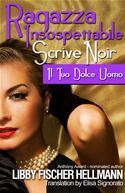
I was also able to make my first foray into foreign language versions of my work this year, and a Spanish translation of EASY INNOCENCE, INOCENCIA FACIL, is now available in both ebook and print! We’re currently working on an Italian version of NICE GIRL DOES NOIR, my short storycollection. Some of the stories are already available in ebook formats here and here. However, selling in foreign markets is a challenge, so if you know anyone who reads in Spanish or Italian, I would be thrilled if you spread the word.
I became an APP this year! For those of you chained to your tablets and smart phones, you can download me directly and find out way too much about what I’m up to. We can even message back and forth. It’s been on Android devices for a while (see the photo on the right –I’m in profile), but the Apple version is imminent, so you might be hearing from me again when it comes out. Oh, did I mention it’s FREE? You can find it here.
[image error]I was honored to be featured in the Chicago Tribune’s PRINTERS ROW JOURNAL a few days ago. It’s a longish profile, complete with photo — and I swear some of it is even true! You can download it as a PDF here.
As many of you know, the world of publishing has changed significantly. Signings, which used to be a tried-and-true way to reach readers, are less well attended now and can be disappointing for both the host and the author. However, there’s a new organization, Togather, that’s trying to remedy it. Here’s the scoop: If your book club, library, bookstore, or other organization might want an author (hopefully, me) to visit your city, all you need to do is click here. The rest is easy. If you can assure a certain number of attendees, I’m there.
You’ll be hearing from me again, hopefully next spring, when my new thriller, GOODBYE CHE (working title — it might change), comes out. Set largely in Cuba, it spans three generations of a Mafia family during the Cuban revolution and the ’90s. Then it moves to Chicago during the present.
Finally, I’ll leave you with an image of me and my touring partner-in-crime, author Cara Black.
Clearly, we’ve been traveling together too long… In fact, we were JUST awarded the “Best Chutzpah Award” on Randy Sue Meyer’s blog post today. Best of all, it’s true.
Thanks for your support … no author does it alone, and I am grateful for your kind words and friendship.
December 30, 2012
Kick Off 2013 Right!
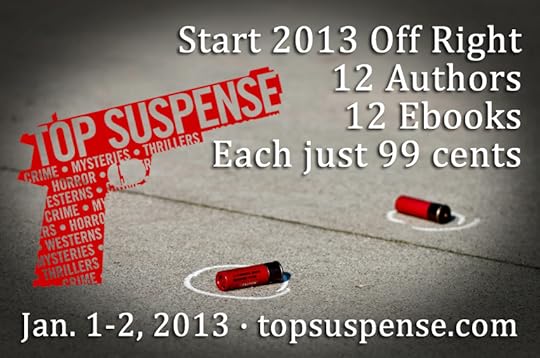
Here it is. The Best. Ever. New Years Ebook Sale.
As many of you know, I’m part of the Top Suspense Group, along with 11 other best-selling thriller, horror, crime, and mystery authors. To kick the year off properly, each of us has lowered the price of one book to 99 cents on Amazon.
It’s just for 2 days… Jan 1-2, 2013… so don’t miss it. You can find the books here and here. Have fun!
December 26, 2012
Epic Kindle Giveaway Sale Starts Thursday…
If you like thrillers, if you just got a Kindle for Christmas, or if you just love to read, you’ll love the Epic Kindle Giveaway Sale. Twelve authors have lowered the price of one of their thrillers to 99 cents. That’s it! Plus, if you enter, you’ll have a chance to win a Kindle Fire, as well as plenty of giftcards!
Sounds easy, right? It is. Take a look at the offerings… then click over here for more details. The sale goes from December 27 through December 29. Enjoy!
December 21, 2012
Un-Frigging-Believable!
Have you seen this? (Screaming allowed. I did.)
Un-Frigging-Believable
Have you seen this? ( Screaming allowed. I did.)


